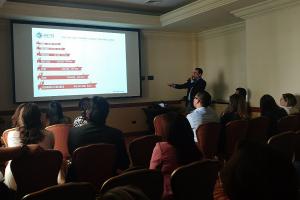More sales of U.S. feed grains and co-products are the direct return on investment for U.S. Grains Council (USGC) work in Central America to help industries expand their operations. In June, the Council utilized a series of three trade schools in Honduras, El Salvador and Panama to promote U.S. competitive advantages in meeting the region’s increased demand for feed.
“The trade school in Central America took place amidst one of the most important investment seasons of the last 50 years,” said Luis Bustamante, USGC marketing specialist for the Western Hemisphere. “These events were a great opportunity to interact with growing Central American industries as well as demonstrate why U.S. feed grains and co-products are a good value.”
The trade schools focused on conveying information about the consistency of sourcing U.S. feed grains from the United States. Participants discussed the advantages of transparency in market prices as well as supply and demand information from the United States, quality monitoring, reliable logistics compared to other origins, options for combination shipments, alternative ingredients and the variety of co-products offered by U.S. sellers.
The United States has a natural market advantage in the Central American region given close proximity and trading preferences set out in the Central America and Dominican Republic Free Trade Agreement (CAFTA-DR), which included the two of the countries hosting the recent round of trade schools. USGC activities in the region since the 1980s have helped establish important partnerships and accelerate regional growth of meat, milk and egg production. Now, as a region, Central America is the fifth largest destination for U.S. corn.
In Panama, home of the USGC regional office for the Western Hemisphere, per capita chicken consumption increased by three pounds between 2015 and 2016, now at 90 pounds per capita. Egg consumption has also increased by 14 percent. Corresponding purchases of U.S. corn of more than 357,000 metric tons (14.1 million bushels) in the current marketing year (September 2016-April 2017) are up 76 percent compared to this time last year.
The poultry industry in El Salvador is also seeing growth including a 6.9 increase in chicken production in 2015. The poultry industry now represents 15.4 percent of El Salvador’s gross domestic product (GDP) and 37.8 percent of total livestock production. El Salvador purchased nearly 654,000 tons (25.7 million bushels) of U.S. corn in 2015/2016 to supply this industry.
Investments in regional infrastructure also benefit U.S. agriculture. The recently expanded port in Puerto Cortes, Honduras, is now the most efficient facility in Central America. The newest grain terminal opened in January 2017 and includes two new berth positions capable of receiving Panamax vessels as well as five 8,000-metric-ton silos and an additional 25,000 tons of storage capacity in warehouses.
The improvement of this port infrastructure has led to growth in other industries as well, including the poultry industry. Poultry exports from Honduras have doubled over the past two years, leading to a corresponding increase in demand for feed. As a result, U.S. corn exports to Honduras have steadily increased over the last five marketing years to about 550,000 tons (21.7 million bushels) last marketing year.
The momentum for consumption and investment in Central America is expected to maintain the pace this year, increasing overall demand for feed and imports from the United States.
“Through USGC activities like the trade school, our customers increase their interest in U.S. corn and realize the value chain advantages of grain from the United States,” Bustamante said. “Continuing to foster trusted, lasting relationships and helping these sectors reach their full potential increases the need for feed grains and solidifies a preference for U.S. supplies.”
Learn more about the Council’s work in Central America here.



